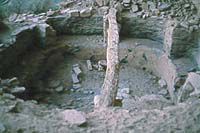| A kiva in the Grand Gulch area of Utah. This kiva is part of the ruins left by the Anasazi. |
At the January meeting of the Emery County Historical Society, Mark H Williams was the speaker for the evening and his topic was the Anasazi Indians of the Four Corners area. “The word Anasazi is a Navajo word that means the ancient ones. The Anasazi lived in the Four Corners area from about 400 A.D. to about 1300 A.D. It is thought that a 20 year drought caused them to migrate into Hopi territory around the year 1276 A.D. This date was arrived at by testing the trees used in the construction of the dwellings used by the Anasazi.
“These people were builders and settlers with three distinct, concentrated groups in the Four Corners area. Mesa Verde in Colorado, Chaco Canyon in New Mexico, and another in Kayente, Ariz. In Mesa Verde the dwellings were large homes on the top of the mesa. In Chaco Canyon, the homes were built against rock walls but were freestanding homes, some with more than 800 rooms. In Grand Gulch, the dwellings were built high up on the rock faces into crevices and indentations in the face of the rock cliffs,” said Williams.
Williams presented a slide show from a visit he made to the Grand Gulch area with several local men and a group of scouts. Several different types of dwellings were shown that illustrated the difference in types of construction. “Just like we are today, the Anasazi each had their own ideas of how a dwelling should be built. There are several different types of construction used in the dwellings. There is “waddle and dob” construction. This is when willows and sticks were used and mixed with mud to hold them together and then mud was “dobbed” over the entire wall. Another type was the brick and mortar type of construction. Brick shaped rocks were gathered and stacked much the same as bricks are today, then mortar was applied to the cracks between the rocks.
“The dwellings had very small doorways which were covered by a rock slab when no one was at home. A few of the doorways were smaller at the bottom and widened near the top. This was so that if a person was entering the dwelling with something in their arms, the wider space at the top would accommodate them,” said Williams.
Williams went on to say that in the Four Corners area, many handprints are found on the rock walls of the canyons. These were applied much the same way as the petroglyphs, with paints and dyes applied to the hand and then pressed onto the rock. In some instances, the print is a negative where the hand was placed on the rock and the dye was somehow sprayed over the hand.
“The Anasazi were a matriarchal society and when a man married a woman, he went to live with the wife’s family, in the same household as his mother-in-law. It is suspected that this is the reason that the Anasazi men built the kiva. A kiva was a large room where the men met to hold religious ceremonies, and possibly trade horror stories concerning living with the mother-in-law.
| Emery County scouts visit the ruins in the Four Corners area. |
“These kivas were built near the center of the community and consisted of a large, round room with seating built around the edge of the room. In the center of the kiva, there was usually a hole in the ground, called a sipapu. It is said that the Anasazi believed that people came from the center of the Earth and the sipapu in the center of the kiva was the outlet for them to make their entrance,” said Williams.
Toward the end of the slide presentation, Williams had photos of Indian writings, not only in the Four Corners area, but here in Emery County as well. One interesting wall painting that was located very near to a dwelling told everyone who came after that the occupants of this dwelling had six children. On the wall, each a different size and color shade, were the footprints of six babies. Williams stated that this was the only one of this kind that he has seen.
At the January meeting, officers were elected for the 2006 year. President-elect Mike Williams was installed as the president and Joyce Staley who has served as secretary for the past year was elected as president-elect. Evelyn Huntsman was elected as secretary and Dixie Swasey was elected to be the treasurer for the historical society.
Sylvia Nelson, historical society member, informed the group of the number books, “A History of Emery County,”that have been sold is 66. The number of books sold determines the amount of money which is donated to the historical society.
Nelson presented a check in the amount of $132 and stated the next project is to be a companion book to this book.
The new book will be a photograph book and will have references from the photos to the information in the first book.
The Emery County Historical Society meets once a month at the Museum of the San Rafael. In February they will meet on Feb. 16 at 6:30 p.m. where they will hear from a speaker on the Spanish Trail.

